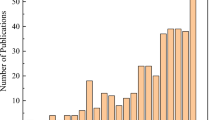Abstract
Load assessment of existing bridges in Australia is evaluated mainly using beam line model and the grillage analogy to examine the structural integrity of bridge components due to live loadings. With the majority of existing bridge networks designed for superseded design vehicular loading, the necessity to utilise more rigorous analysis methods to assess the load effects of bridges is indispensable. In this paper, various vehicular loading cases on a grillage model of a box girder bridge and its equivalent finite element model (FE) are considered, and their applicability for bridge assessment using structural health monitoring (SHM) as defined in the new revision of AS 5100.7 is studied. Based on numerical analyses, it was observed that component-level load effects in the two models have notable differences, irrespective of vehicle speed, position and loading. However, when global-level load responses are compared, the discrepancy in analysis outputs drops dramatically. The modelling ratios developed in this paper are practical and will be applicable with any modelling techniques for bridge assessment under vehicular loading on both a global and component-response basis. It was also observed that FE is more efficient in terms of model updating and damage simulation, and hence more appropriate for implementation of SHM techniques. The proposed flowchart suggested for heavy load assessment incorporates detailed and simple modelling approaches aligned with experimental data obtained by SHM techniques, which can be used for periodic and long-term monitoring of bridges. It can enhance the proper determination of bridge condition states, as any conservative estimation of bridge capacity may result in unnecessary load limitations.











Similar content being viewed by others
References
Shaw P, Pritchard R, Heywood R (2014) Bridge analysis: are we data managers or engineers? In: Proceedings of 9th Austroads bridge conference, Sydney, New South Wales, Australia
Morrison S, Moses J (2011) Benefits and uses of FE modelling in bridge assessment and design. In: Proceedings of the 8th Austroads bridge conference, Sydney, New South Wales, Australia
Jamali S, Chan THT, Thambiratnam DP, Ross Pritchard, Nguyen A (2016) Pre-test finite element modelling of box girder overpass-application for bridge condition assessment. In: Proceedings of the Australasian structural engineering conference (ASEC), Brisbane, Australia
Jaeger LG, Bakht B (1982) The grillage analogy in bridge analysis. Can J Civ Eng 9(2):224–235
Lu P, Li F, Shao C (2012) Analysis of a T-frame bridge. Math Probl Eng 2012. http://dx.doi.org/10.1155/2012/640854
Sadeghi J, Fathali M (2012) Grillage analogy applications in analysis of bridge decks. Aust J Civ Eng 10(1):23–36. https://doi.org/10.7158/c10-670.2012.10.1
Yang M, Zhong H, Telste M, Gajan S (2016) Bridge damage localization through modified curvature method. J Civ Struct Health Monit 6(1):175–188. https://doi.org/10.1007/s13349-015-0150-7
McElwain BA, Laman JA (2000) Experimental verification of horizontally curved I-girder bridge behavior. J Bridge Eng 5(4):284–292. https://doi.org/10.1061/(asce)1084-0702(2000)5:4(284)
Krzmarzick DP, Hajjar JF (2006) Load rating of curved composite steel I-girder bridges through load testing with heavy trucks. In: Structures Congress, 2006. https://doi.org/10.1061/40889(201)149
Queensland Department of Transport and Main Roads (2013) Tier 1 heavy vehicle bridge assessment criteria. Transport and Main Roads (TMR), Queesnland, Australia
Australian Standards (2017) Bridge design—part 2: design loads (AS 5100.2). SAI Global, Sydney
Australian Standards (2017) Bridge design—part 7: bridge assessment (AS 5100.7). SAI Global, Sydney
Pritchard R (2014) AS 5100.7 bridge assessment: 2014 revision. In: Proceedings of the 9th Austroads bridge conference, Sydney, Australia
Pritchard R (2017) Revision of Australian Standard AS 5100 part 7: bridge assessment. In: Proceedings of the 10th Austroads bridge conference, Melbourne
Hambly EC (1991) Bridge deck behaviour, 2nd edn. E & FN Spon, London
Qaqish M, Fadda E, Akawwi E (2008) Design of T-beam bridge by finite element method and AASHTO specification. KMITL Sci J 8(1):24–34
Jenkins D (2004) Bridge deck behaviour revisited. In: Proceedings of the 5th Austroads bridge conference, Hobart, Tasmania
Obrien EJ, Keogh D, O’Connor A (2014) Bridge deck analysis, 2nd edn. CRC Press, Boca Raton, Flordia
Surana C, Agrawal R (1998) Grillage analogy in bridge deck analysis. Narosa, New Delhi
Australian Standards (2017) Bridge design—part 5: concrete (AS 5100.5). SAI Global, Sydney
Reddy JN (2006) Theory and analysis of elastic plates and shells, 2nd edn. CRC Press, Bosa Roca
Moravej H, Jamali S, Chan THT, Nguyen A (2017) Finite element model updating of civil engineering infrastructures: a review literature. In: International conference on structural health monitoring of intelligent infrastructure, Brisbane, Australia
Hambly E, Pennells E (1975) Grillage analysis applied to cellular bridge decks. Struct Eng 53(7):267–276
National Association of Australian State Road Authorities (1976) NAASRA bridge design specification, 5th edn. National Association of Australian State Road Authorities, Sydney
AECOM Australia (2002) Investigating the development of a bridge assessment tool for determining access for high productivity freight vehicles (AP-R398-12). https://www.onlinepublications.austroads.com.au/items/AP-R398-12. Accessed 1 Jun 2016
Lake N, Ngo H, Kotze R (2014) Review of AS 5100.7 rating of existing bridges and the bridge assessment group guidelines (AP-R452-14). https://www.onlinepublications.austroads.com.au/items/AP-R466-14. Accessed 1 Jun 2016
Lake N, Seskis J, Ngo H, Kotze R (2014) Review of axle spacing mass schedules and future framework for assessment of heavy vehicle access applications (AP-R466-14). https://www.onlinepublications.austroads.com.au/items/AP-R466-14. Accessed 1 Jun 2016
Pritchard R, Heywood R, Shaw P (2014) Structural assessment of freight bridges in Queensland. In: Proceedings of the 9th Austroads bridge conference, Sydney, New South Wales, Australia
Schlune H, Plos M (2008) Bridge assessment and maintenance based on finite element structural models and field measurements. Chalmers University of Technology, Göteborg
Acknowledgements
The first author is thankful for full financial support provided by Queensland University of Technology. Also, valuable comments provided by Prof. Eugene O’Brien for grillage modelling is appreciated.
Author information
Authors and Affiliations
Corresponding author
Rights and permissions
About this article
Cite this article
Jamali, S., Chan, T.H.T., Nguyen, A. et al. Modelling techniques for structural evaluation for bridge assessment. J Civil Struct Health Monit 8, 271–283 (2018). https://doi.org/10.1007/s13349-018-0269-4
Received:
Accepted:
Published:
Issue Date:
DOI: https://doi.org/10.1007/s13349-018-0269-4




